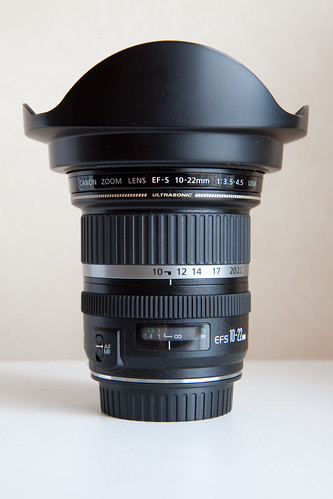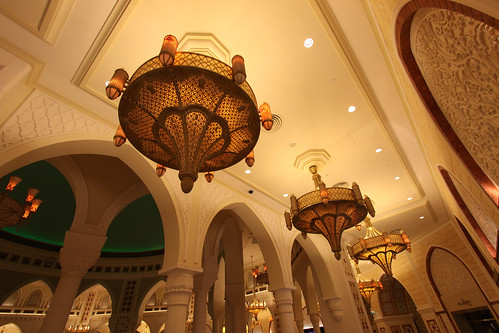
The Canon EF-S 10-22mm f/3.5-4.5 USM Lens is an ultra wide angle lens for the Canon EF-S camera body range. It gives a framing equivalent to a 16-35 mm on a full body.
My lens came with the following accessories:
- Canon 77mm lens cap
- Canon lens case LR1319
In the photo you can see the following accessories, which I have bought separately:

Lens with lens hood attached
The weight of this lens is 385 grams, which is much lighter than my Canon 17-55 f/2.8 IS USM lens (645 grams). The lens does not extend during zooming, which is different than the Canon 17-55mm lens. I don’t mind the maximum aperture of f/3.5-4.5 because I will be shooting at smaller apertures for a maximum depth of field. The front of the lens does not rotate while zooming or focusing. This is useful when you are using a polarizing or ND grad filter.
To my surprise this lens came with a lens case. Only Canon L lenses are supplied with a lens case, or a lens hood for that matter. The Canon 17-55mm f/2.8 IS USM lens also fits in this case.
I am using the JJC lens hood for lens protection. It uses a bayonet mount to attach to the lens. You can also attach it backwards when you store the lens. it screws on rather stiff at the moment. Perhaps this will change in the future.
The B+W 77 010 UV MRC 77mm filter is used to seal off the lens at the front, and to protect the front element from rain, dust and scratches. I choose the MRC coating because it is easy to clean. When I use another filter (like my polarizing filter), the UV filter is removed from the lens. Filter stacking is a bad idea, and you run the risk that you cannot unscrew the filters from each other.
This lens is really wide! It is useful for architecture or for creative photos:

You have to be careful not to photograph unwanted objects in the edges of your shots. This lens is so wide that it picks up everything! For instance when I am adjusting my polarizing filter on this lens and take a picture at 10mm, I have to remember not to touch the filter ends with my fingers. If I don’t move my fingers they end up in the edges of the shot. This does not happen with other lenses like the Canon 17-55mm, 50mm or 85mm.
Until now, I have rarely seen lens flare while taking photos without the lens hood, with the UV filter attached. That is a good thing. Since this lens is so wide, you are bound to get the sun or some other light source directly into your photo. Your mileage may vary of course. The MRC coating plays a part in suppressing lens flare. So make sure you use a good filter!
I also used the hood, but the hood is rather awkward (wide) when you want to store the lens in your bag. So I made more photos without the hood than with the hood. Sometimes the lens hood is not enough, and you have to use your hand or something else anyway to block the light source. Again, make sure your ‘gobo’ does not appear in the edges of the photo!
The lens is a joy to use. Photos need little post processing since the distortion of the lens is very low. I am pleased with it because I can now easily take photos of very large rooms with one shot. See the Dubai Mall post for examples. Many of the photos were made with this lens. I have used the Canon 10-22mm lens with the B+W 77mm MRC Slim Circular Polarizer Filter and have no problems with any kind of vignetting (besides my own fingers as described earlier). See the photos of the Tesla Motor Roadster for examples of shots with the polarizing filter.
UPDATE: On my Canon 50D I have enabled peripheral illumination correction. It could be that this feature corrects the vignetting.
The zoom range of the Canon 10-22mm lens nicely complements my existing Canon 17-55mm lens. I have bought the lens to shoot primarily at 10mm. The 22mm end is useful to shoot reasonably wide shots without the ultra wide distortion. Having 22mm to do this is nice, it saves me some lens swapping when I want to do an ultra wide shot and a normal wide shot. With this in mind you can use the Canon 10-22mm as a sort of ‘walk-around’ lens for cities or architecture.
So, if you consider one, go get one, read Ken Rockwell’s review of this lens and his article on ultra wide angle lenses and start taking photos!

Taxi Stand at Ibn Battuta Mall, Dubai






